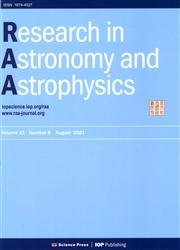基于ERA5数据库的Muztagh-ata站点高度和时间观测定量分析
IF 2.8
4区 物理与天体物理
Q3 ASTRONOMY & ASTROPHYSICS
引用次数: 0
摘要
观测是评价天文站点质量的一项重要指标。为了定量估计Muztagh-ata站点的高度和时间,使用了欧洲中期天气预报中心再分析数据库(ERA5)。用ERA5计算的视觉与差分图像运动监视器(DIMM)在12 m高度的视觉进行了一致的比较。结果表明:木兹塔格塔遗址的能见度随高度呈指数衰减。2021年秋季的能见度衰减最快,夏季随高度变化最慢。秋天的视觉条件比夏天好。12 m观测中值为0.89 arcsec, 8月最大值为1.21 arcsec, 10月最小值为0.66 arcsec。12米的观测中值夜间为0.72弧秒,白天为1.08弧秒。视力是与温度和风速同阶段的年和大约两年变化的组合,表明视力随时间的变化受温度和风速的影响。用理查德森数Ri分析了大气稳定性,观测值的变化与层间的Ri一致。这些定量化结果将为望远镜观测策略的制定提供重要参考。本文章由计算机程序翻译,如有差异,请以英文原文为准。
Quantitative analysis of seeing with height and time at Muztagh-ata site based on ERA5 database
Abstract Seeing is an important index to evaluate the quality of an astronomical site. To estimate seeing at Muztagh-ata site with height and time quantitatively, European Centre for Medium-Range Weather Forecasts Reanalysis database(ERA5) is used. Seeing calculated from ERA5 is compared consistently with the Differential Image Motion Monitor(DIMM) seeing at the height of 12 m. Results show that seeing decays exponentially with height at Muztagh-ata site. Seeing decays the fastest in autumn in 2021 and most slowly with height in summer. The seeing condition is better in autumn than in summer. The median value of seeing at 12 m is 0.89 arcsec, the maximum value is 1.21 arcsec in August and the minimum is 0.66 arcsec in October. The median value of seeing at 12 m is 0.72 arcsec in the nighttime and 1.08 arcsec in the daytime. Seeing is a combination of annual and about biannual variations with the same phase as temperature and wind speed indicating that seeing variation with time is influenced by temperature and wind speed. The Richardson number Ri is used to analyze the atmosphere stability and the variations of seeing are consistent with Ri between layers. These quantitative results would provide important reference for telescope observation strategy.
求助全文
通过发布文献求助,成功后即可免费获取论文全文。
去求助
来源期刊

Research in Astronomy and Astrophysics
地学天文-天文与天体物理
CiteScore
3.20
自引率
16.70%
发文量
2599
审稿时长
6.0 months
期刊介绍:
Research in Astronomy and Astrophysics (RAA) is an international journal publishing original research papers and reviews across all branches of astronomy and astrophysics, with a particular interest in the following topics:
-large-scale structure of universe formation and evolution of galaxies-
high-energy and cataclysmic processes in astrophysics-
formation and evolution of stars-
astrogeodynamics-
solar magnetic activity and heliogeospace environments-
dynamics of celestial bodies in the solar system and artificial bodies-
space observation and exploration-
new astronomical techniques and methods
 求助内容:
求助内容: 应助结果提醒方式:
应助结果提醒方式:


